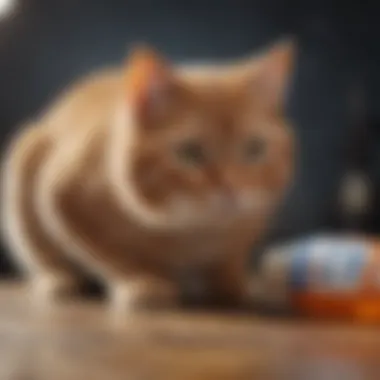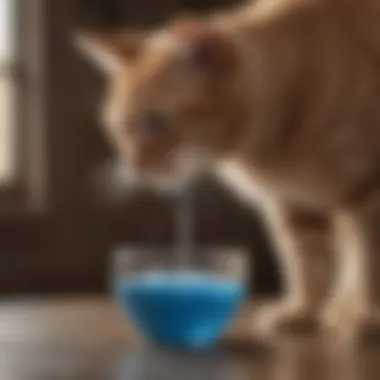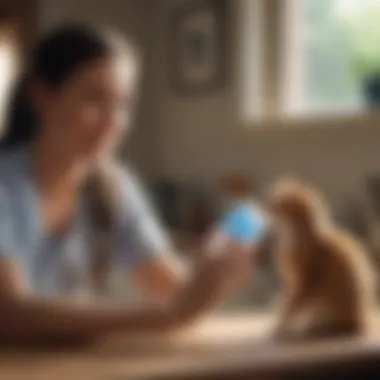Can I Give My Cat Pedialyte? Understanding Its Use and Implications


Intro
Hydration is crucial for all living beings, especially for pets like cats. As pet owners, understanding the hydration needs of our feline companions can be vital for their health. One common question arises: Can Pedialyte be safely given to cats? This article aims to provide clarity on this matter, exploring the purpose of Pedialyte, its benefits, dosage recommendations, and alternative rehydration methods. It will also discuss risks and the importance of veterinary guidance.
Animal Overview
Cats, scientifically known as Felis catus, are small mammals that are widely cherished as companions. They belong to the family Felidae and are known for their agility and grace.
Common Name and Scientific Classification
The common name for the domestic cat is simply
Intro to Feline Hydration
Hydration is one of the most significant aspects of a cat's health, yet it often goes unnoticed until a problem arises. This section aims to illuminate why proper hydration is essential for felines, as well as the factors that contribute to dehydration. Understanding these elements can help pet owners ensure their cats maintain adequate fluid balance and overall health.
Why Hydration is Crucial for Cats
Cats, like all living beings, require water for survival. However, their unique physiology places particular emphasis on the need for adequate hydration. Cats rely heavily on water for several vital functions:
- Digestion: Water aids in the breakdown of food and absorption of nutrients.
- Temperature Regulation: Adequate hydration helps in maintaining a stable body temperature.
- Kidney Function: Cats are prone to urinary tract issues; hydration supports kidney health by diluting urine, thus preventing crystallization.
- Circulatory Health: Water is essential for maintaining blood volume and circulation throughout the body.
Given these crucial functions, any signs of dehydration should not be taken lightly. A cat that becomes dehydrated is at risk for severe health issues, including organ failure and metabolic imbalances.
Common Causes of Dehydration in Cats
Several factors contribute to dehydration in cats, making it essential for owners to recognize these risks early. Common causes of dehydration include:
- Inadequate Water Intake: Cats may not drink enough water if they depend solely on a bowl. Many cats prefer running water and may be disinterested in stagnant sources.
- Dietary Choices: Cats on a dry food diet often receive less moisture than those on wet food.
- Illness: Diseases such as kidney disease, diabetes, and hyperthyroidism can lead to increased urination, resulting in fluid loss.
- Environmental Factors: Heat and humidity can increase a cat's water requirements, especially during the summer months.
- Vomiting and Diarrhea: Gastrointestinal issues can cause rapid fluid loss and require immediate attention.
Recognizing these causes enables cat owners to take proactive measures in ensuring their pets are properly hydrated. Addressing the underlying factors leading to dehydration can significantly improve a cat's quality of life.
What is Pedialyte?
Pedialyte is a rehydration solution formulated to replenish fluids and electrolytes in individuals experiencing dehydration. Understanding what Pedialyte is can help pet owners make informed decisions regarding feline care, especially in hydration management. This section lays the foundation for further discussion on its implications and potential benefits for cats.
Composition of Pedialyte
Pedialyte's careful composition makes it an effective hydration solution for humans, and this profile is essential to recognize when considering its use for cats. Typically, Pedialyte contains water, electrolytes such as sodium and potassium, and carbohydrates. The ratio of these components is designed to promote optimal absorption and to combat dehydration caused by various factors such as illness, heat, or physical exertion.
The formulation's design is integral; it uses a specific blend of sodium and glucose to enhance the absorption of fluids in the intestines. Sodium plays a pivotal role in maintaining fluid balance and aiding muscle function, while glucose helps in the uptake of sodium, facilitating effective hydration. The inclusion of potassium supports cellular function and helps regulate bodily fluids, providing comprehensive benefits during rehydration.
Intended Uses in Humans


Pedialyte is widely used for rehydrating adults and children who are losing fluids due to diarrhea, vomiting, or fever. Its primary objective is to restore electrolytes and prevent dehydration, which can significantly impact overall health. The specific recommend uses for human application primarily include:
- Recovery from gastrointestinal issues: It is often recommended to combat dehydration caused by conditions such as gastroenteritis.
- Post-exercise rehydration: Athletes use Pedialyte to recover lost fluids and electrolytes after extensive physical activity.
- Illness-related hydration: It can be beneficial when facing fever or any condition that causes excess fluid loss.
In these scenarios, the properties of Pedialyte prove beneficial for maintaining hydration levels effectively and efficiently. Pet owners evaluating the use of Pedialyte for their feline companions should consider both its advantages and limitations based on its human-centric formulation.
Pedialyte for Cats: A Consideration
The use of Pedialyte for cats raises several important questions and considerations. As pet owners become more conscious of their feline companions' hydration needs, understanding the implications of using a product designed for humans becomes increasingly relevant. This section explores whether cats can safely consume Pedialyte, potential benefits, and key factors to consider.
Can Cats Safely Consume Pedialyte?
While Pedialyte is generally safe for human consumption, its application in feline health is less straightforward. Cats have unique metabolic processes, and their dietary needs differ from humans. The formulation of Pedialyte includes electrolytes, which can be helpful in certain situations. However, it is crucial to ensure that the product does not contain added sugars or artificial flavors that may be unsuitable for cats.
Several veterinarians and pet nutritionists suggest that, in small quantities, undiluted or diluted Pedialyte may be safe for cats experiencing mild dehydration. This situation is often due to vomiting, diarrhea, or heat stress. It is essential to monitor the cat closely after administration for any adverse reactions. Still, consulting a veterinarian before introducing any human product into an animal's diet is always recommended.
Possible Benefits of Pedialyte for Cats
There are some potential benefits associated with giving Pedialyte to cats, especially when they are recovering from dehydration. These benefits include:
- Electrolyte Restoration: Pedialyte contains vital electrolytes like sodium and potassium, which can help restore balance in cases of dehydration.
- Convenience: For pet owners, Pedialyte can be a readily available option, especially when commercial rehydration solutions are not on hand.
- Avoiding Serious Health Issues: Proper rehydration can prevent more severe health complications often arising from dehydration, such as kidney issues or metabolic imbalances.
Again, caution is necessary. Too much Pedialyte or unsuitable ingredients can create complications.
Always consider seeking professional veterinary advice before administrating Pedialyte or similar solutions to ensure that it aligns with your cat's specific health conditions.
In summary, while Pedialyte may offer specific benefits to cats dealing with dehydration, each situation must be evaluated individually. Careful consideration and veterinary guidance are essential to ensuring the health and safety of our feline friends.
Dosage and Administration Guidelines
Administering Pedialyte to cats requires careful consideration of dosage and methods of administration. Ensuring the correct dosage can be crucial for the effectiveness of this solution while minimizing potential risks. Each cat is different, and factors such as weight, age, and overall health can influence how much Pedialyte is appropriate. Thus, proper guidelines help to ensure safety and efficacy, making understanding these guidelines essential for any cat owner.
Determining the Right Dosage
When determining the right dosage of Pedialyte for a cat, one must consider several important aspects. Generally, a conservative approach is best. As a rule of thumb, a small amount—approximately 5 to 10 ml per pound of body weight—might be suggested. However, this guideline can vary between individual cats. Cats that are severely dehydrated may need more frequent doses.
Factors to assess include:
- Weight of the Cat: Accurate weight is crucial to calculate the right dosage.
- Severity of Dehydration: More severely dehydrated cats could require higher dosage and frequency.
- Existing Health Conditions: Cats with specific medical conditions might respond differently, so veterinary advice is often necessary.
Before giving any amount of Pedialyte, it is advisable to consult with a veterinarian for precise recommendations. Monitoring is also vital. If you observe any adverse reactions, discontinue use and seek professional help.
How to Administer Pedialyte to Cats


Administering Pedialyte can be straightforward if some basic methods are followed. Here are a few practical ways:
- Syringe Method: Using a syringe, you can carefully give small doses. Ensure you do not squirt it directly down the throat to avoid choking.
- Mix with Regular Food: A small amount of Pedialyte can be mixed with wet cat food. This method can make it more palatable, encouraging the cat to consume it.
- Water Bowl Addition: If your cat is more agreeable, you can add diluted Pedialyte to their water bowl. However, be sure it is not overly concentrated.
Important: Always observe your cat’s reactions during and after administration. If they seem uncomfortable or show signs of distress, it is crucial to stop immediately and consult your veterinarian.
Regular assessment and adjustment of these methods will help ensure that your cat receives the necessary rehydration without unnecessary stress.
Potential Risks and Side Effects
Understanding the potential risks and side effects of giving Pedialyte to cats is essential for pet owners. Although it may serve as a temporary solution for dehydration, there are important considerations that must be taken into account. Pedialyte contains certain ingredients and electrolytes that may not be suitable for all felines, which could lead to complications. Being informed about these risks is crucial to ensuring the health and wellbeing of your pet.
Understanding Electrolyte Imbalance
Electrolyte balance is vital for proper bodily function. When cats become dehydrated, their electrolyte levels can drop. While Pedialyte can help replenish these levels, incorrect usage can have the opposite effect. Some electrolytes that exist in Pedialyte, such as sodium and potassium, may not suit every cat's condition. Too much sodium, for instance, can lead to issues like hypertension or kidney problems.
Other health conditions, like heart disease or renal failure, may also be exacerbated by added electrolytes. It's crucial to consult with a veterinarian before offering Pedialyte to your cat. Only they can assess whether Pedialyte is a fit option based on your cat's medical history and current state of health.
Signs of Adverse Reactions
Monitoring your cat for signs of adverse reactions after administering Pedialyte is essential. These reactions can range from mild to severe. Some common symptoms to look for include:
- Vomiting
- Diarrhea
- Lethargy
- Changes in appetite
- Excessive thirst
- Restlessness or agitation
If you notice any of these signs, it is crucial to contact a veterinarian immediately. Early intervention can make a significant difference in managing potential health issues caused by electrolyte imbalances or adverse reactions to Pedialyte.
Important Note: Always prioritize your cat’s health over any homemade remedies or quick fixes. Consult a veterinary professional for personalized advice on hydration solutions, specifically for your pet.
Veterinary Perspectives on Pedialyte for Cats
Veterinary insights on the use of Pedialyte for cats is essential. This section addresses the professional viewpoints regarding hydration solutions for felines. Understanding these perspectives helps pet owners make informed decisions about their cat's health. Vets consider many factors before recommending solutions. The cat's overall health, specific dehydration cause, and individual needs play crucial roles.
When to Consult a Veterinarian
Pet owners should consult a veterinarian if they notice signs of severe dehydration in their cat. These signs include:
- Lethargy
- Dry gums
- Loss of appetite
- Significant weight loss
- Sunken eyes
Noticing these symptoms warrants an immediate call to a veterinary clinic. It is vital to ensure proper diagnosis and treatment, as hydration methods vary widely based on the condition. A vet may recommend Pedialyte in specific cases, but only after assessing the cat's unique needs.
"Consulting a veterinarian is always the safe course of action when it comes to your pet's health."
Early intervention is crucial. Dehydration can progress quickly, leading to serious health problems. Thus, seeking a veterinary opinion can save time and potentially restore your cat’s health.


Veterinary Recommendations
Vets typically recommend specific types of hydration solutions based on the severity of dehydration. These recommendations may include:
- Oral Rehydration Solutions: Some vets suggest using Pedialyte in diluted form. However, they emphasize monitoring and caution.
- Commercial Hydration Products: Solutions designed for pets often provide an electrolyte balance better suited for felines.
- Subcutaneous or Intravenous Fluids: In cases of severe dehydration, professionals may administer fluids directly into the body.
Veterinarians may also suggest alternative methods for hydration, such as encouraging cats to drink more water or providing wet food. Pet owners should follow veterinary advice to ensure the best outcomes for their cats. Proper hydration is key to maintaining health and well-being in felines.
Hydration Alternatives for Cats
Ensuring that cats stay hydrated is a fundamental aspect of their health management. While Pedialyte may offer potential benefits in certain situations, it is crucial to explore other hydration alternatives available for our feline friends. This section delves into various commercial rehydration solutions and natural hydration methods that can support cats in maintaining optimal hydration levels. Considering these alternatives enables pet owners to make informed decisions that align with their cat's specific needs and health conditions.
Commercial Rehydration Solutions
Commercial rehydration solutions are designed to replenish lost fluids and electrolytes in pets. These products are often formulated with specific concentrations of electrolytes and fluids to effectively combat dehydration.
- Electrolyte Solutions: Many veterinary products are available that cater specifically to the needs of pets. Some popular brands include Vet’s Choice Hydration, Royal Canin Veterinary Diet, and Hill's Prescription Diet. These solutions are designed to mimic the electrolyte balance found in an animal's body, making absorption more effective.
- Hydration Packs: Ready-to-use hydration packs, often sold in liquid form, can be easily administered to cats. These packs usually contain balanced electrolytes and come in flavored options, which may encourage a reluctant cat to drink.
- Powdered Forms: Some pet owners may prefer powdered rehydration products due to ease of storage and dosage flexibility. These options can be mixed with water to create a drinkable solution. Popular examples include products from Pet MD and Equine Medical.
While these commercial solutions offer convenience, pet owners must choose wisely based on their cat's dietary needs and medical condition. It is advisable to consult with a veterinarian before making any changes to a cat's hydration strategy.
Natural Hydration Methods
In addition to commercial products, there are various natural hydration methods that can effectively support feline hydration. These methods are often more in line with a cat's instinctual behaviors and preferences.
- Fresh Water Availability: Always ensure that fresh water is readily available. Cats can be deterred by stale water. Regularly changing the water bowl encourages them to drink more.
- Wet Food: Incorporating wet cat food into a diet can significantly increase fluid intake. Brands like Wellness CORE and Fancy Feast offer high-moisture content options that are appealing to most cats.
- Broth and Soups: Unsalted chicken or beef broth (not containing onions or garlic) can serve as an excellent alternative. This can be served as a treat or mixed with dry food to improve palatability.
- Water Fountains: Many cats are attracted to flowing water. Using water fountains can encourage them to drink more by appealing to their playful nature. Brands such as Catit or PetSafe offer options that are easy to clean and maintain.
Natural methods are often simple and effective, but they may not always provide the quick replenishment needed in severe dehydration cases. Understanding how your cat prefers to hydrate can help in selecting the best options to support their health.
Remember: Hydration is a continuous process for cats, not just a one-time effort. Assess their hydration needs regularly, especially during hot weather or after exercise.
The End on Using Pedialyte for Cats
Understanding the implications of using Pedialyte for cats is important for pet owners and caregivers. This article highlights various aspects, including the benefits, risks, and alternative hydration methods. It also emphasizes the need for careful consideration regarding any health decisions related to a pet's hydration.
While Pedialyte can have potential advantages for rehydrating cats, especially during instances of mild dehydration, it should not be a first choice for all situations. The electrolyte balance is crucial. There can be risks connected to improper dosage or underlying health issues that warrant veterinary intervention.
"Always prioritize natural hydration methods and consult a veterinarian if your cat shows signs of severe dehydration."
Final Thoughts on Feline Hydration
Feline hydration should not be overlooked. Cats often do not drink enough water due to their natural instincts. They prefer to obtain moisture from their food sources. Therefore, keeping fresh water available at all times is key. This approach can help to prevent dehydration in the first place.
When considering any rehydration solutions, it is beneficial to be informed about the options. Pedialyte may serve as a temporary solution during specific scenarios, but this should be viewed as one part of a broader hydration strategy. The priority should always be on improving the cat’s overall health and well-being.
Balancing Pet Care and Health Recommendations
Striking a balance between pet care and health recommendations involves assessing your cat’s unique needs. Each cat has different dietary preferences and medical conditions that can affect hydration. Pet owners should be cautious about relying solely on commercial products like Pedialyte. Natural solutions, such as wet food or specific broths that are safe for cats, can also contribute to hydration.
Additionally, regular veterinary check-ups are essential for maintaining good health. These visits can provide insight into the hydration status of your cat and help identify any underlying health issues early. In summary, being proactive about hydration and taking medical advice into account ensures optimal care for your feline friend.







